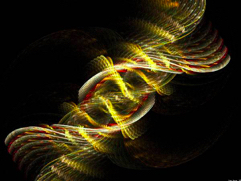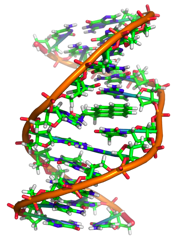DNA
Humans have 23 pairs of chromosomes containing their DNA blueprint. One member of each chromosomal pair comes from their mother, th e other comes from their father. Every cell in a human body contains a copy of this DNA. The large majority of DNA does not differ from person to person, but 0.10 percent of a person's entire genome would be unique to each indiviual. This represents 3 million base pairs of DNA.
e other comes from their father. Every cell in a human body contains a copy of this DNA. The large majority of DNA does not differ from person to person, but 0.10 percent of a person's entire genome would be unique to each indiviual. This represents 3 million base pairs of DNA.
Genes make up 5 percent of the human genome. The other 95 percent are non-coding sequences, (which used to be called junk DNA). In non-coding regions there are identical repeat sequences of DNA, which can be repeated anywhere from one to 30 times in a row. These regions are called variable number tandem repeats (VNTRs). The number of tandem repeats at specific places (called loci) on chromosomes varies between individuals. For any given VNTR loci in an individual's DNA, there will be a certain number of repeats. The higher number of loci are analysed, the smaller the probability to find two unrelated individuals with the same DNA profile.

DNA profiling determines the number of VNTR repeats at a number of distinctive loci, and use it to create an individual's DNA profile. The main steps to create a DNA profile are: isolate the DNA (from a sample such as blood, saliva, hair, semen, or tissue), cut the DNA up into shorter fragments containing known VNTR areas, sort the DNA fragments by size, and compare the DNA fragments in different samples.
Advantages:
Disadvantages
DNA evidence has been used in courts of law since 1985 to prove guilt or innocence. It is also used for paternity testing, and the identification of missing or dead people.
DNA's uniqueness is such that even so-called identical twins do not share the same DNA1, making it the most reliable biometric identifier.
More at:
DNA biometrics
DNA Biometrics
Identical Twins' Genes Are Not Identical
Plex-ID Electrospray Time-of-Flight Mass Spectrometer for Mitochondrial DNA Base Composition Profiling
Footnotes:
Humans have 23 pairs of chromosomes containing their DNA blueprint. One member of each chromosomal pair comes from their mother, th

Genes make up 5 percent of the human genome. The other 95 percent are non-coding sequences, (which used to be called junk DNA). In non-coding regions there are identical repeat sequences of DNA, which can be repeated anywhere from one to 30 times in a row. These regions are called variable number tandem repeats (VNTRs). The number of tandem repeats at specific places (called loci) on chromosomes varies between individuals. For any given VNTR loci in an individual's DNA, there will be a certain number of repeats. The higher number of loci are analysed, the smaller the probability to find two unrelated individuals with the same DNA profile.

DNA profiling determines the number of VNTR repeats at a number of distinctive loci, and use it to create an individual's DNA profile. The main steps to create a DNA profile are: isolate the DNA (from a sample such as blood, saliva, hair, semen, or tissue), cut the DNA up into shorter fragments containing known VNTR areas, sort the DNA fragments by size, and compare the DNA fragments in different samples.
Advantages:
- Accurate: the chance of 2 individuals sharing the same DNA profile is less than one in a hundred billion with 26 different bands studied.
Disadvantages
- DNA matching is not done in real-time
- Intrusive: a physical sample must be taken, while other biometric systems only use an image or a recording
- Civil liberty issues and public perception
- Cost
DNA evidence has been used in courts of law since 1985 to prove guilt or innocence. It is also used for paternity testing, and the identification of missing or dead people.
DNA's uniqueness is such that even so-called identical twins do not share the same DNA1, making it the most reliable biometric identifier.
More at:
DNA biometrics
DNA Biometrics
Identical Twins' Genes Are Not Identical
Plex-ID Electrospray Time-of-Flight Mass Spectrometer for Mitochondrial DNA Base Composition Profiling
Footnotes: